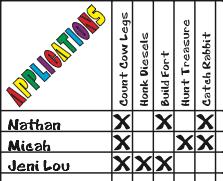 |
||
• : Count the legs of the yearling cows on the property.
• : Acquire data on the number of 18-wheelers that pass in front of the property that honk in response to the “honk” signal: pumping one’s fist up and down in the air. Report in terms of percents. Calculators may be used to figure the percents. Prerequisite: Lesson on percent.
• : Using the wood in the scrap pile and the tools and nails provided, build a fort. Campers may work on it more than once. When the fort is half or more finished, have campers draw a picture of it and identify aspects of it that are horizontal, perpendicular, parallel, triangular, square, rectangular, circular, similar, congruent, a right angle, an acute angle, and an obtuse angle. Prerequisite:
• Follow the instructions on a treasure map to find a treasure. The instructions require knowing how to use a magnetic compass and how to pace off long distances in meters. Campers may keep the treasures they find. Prerequisites: Unit on degree measurement using and and the meter-liter-gram unit.
• : Make a and set a trap to catch a rabbit. Prerequisite: Unit on using .
Instructors were assigned to activities on a nightly basis after the children had gone to sleep (or at least to their rooms with lights out). Because of the varied curriculum, it was usually possible to allow instructors to choose what they wanted to do the next day, at least for concepts and applications. For basics, all but one of us guided children through the aforementioned computational skills program. The remaining instructor worked with the youngest children on the number facts and individualized with a set of worksheets keyed to a set of audio tapes.
Count Cow Legs deserves special mention. The motivation for the activity was Paul’s insistence on having the campers—all city kids—experience the 40 head of cattle on the property. The math in the activity—just counting—was the rationale he

• : Determine pi by measuring the circumference (C) and diameter (d) of circles outdoors and determining the ratio of C to d with calculators. Prerequisite: Meter-liter-gram unit.
• : Classify bugs by size, color, number of legs, ..., whatever.
• : Collect different size leaves from several trees. For each tree, determine if the leaves from the tree meet the similarity criterion—that corresponding parts of similar figures are in proportion—by measuring the length (L) and width (W) of the leaves and computing L÷W with calculators. Prerequisite: Unit on similar figures and proportionality.
• : Make and drop paper helicopters from a tree onto an array of tiles. Drop 100 helicopters and keep track of the number that land on, say, four designated tiles. Report the number as a percent of helicopters dropped and discuss the bias of “aiming” for notable deviations from the theoretical probability of 4/100= 4%. Prerequisites: Lessons on chance and percent.
• : Determine the nature of a swing or pendulum. Swing different sized campers and use a stop watch to measure the period—the time it takes to make one complete back-and-forth swing. Push some real hard and others real easy. Repeat except on the rope swing to vary on the length of the swing by having campers sit on the high knot and then the low one.